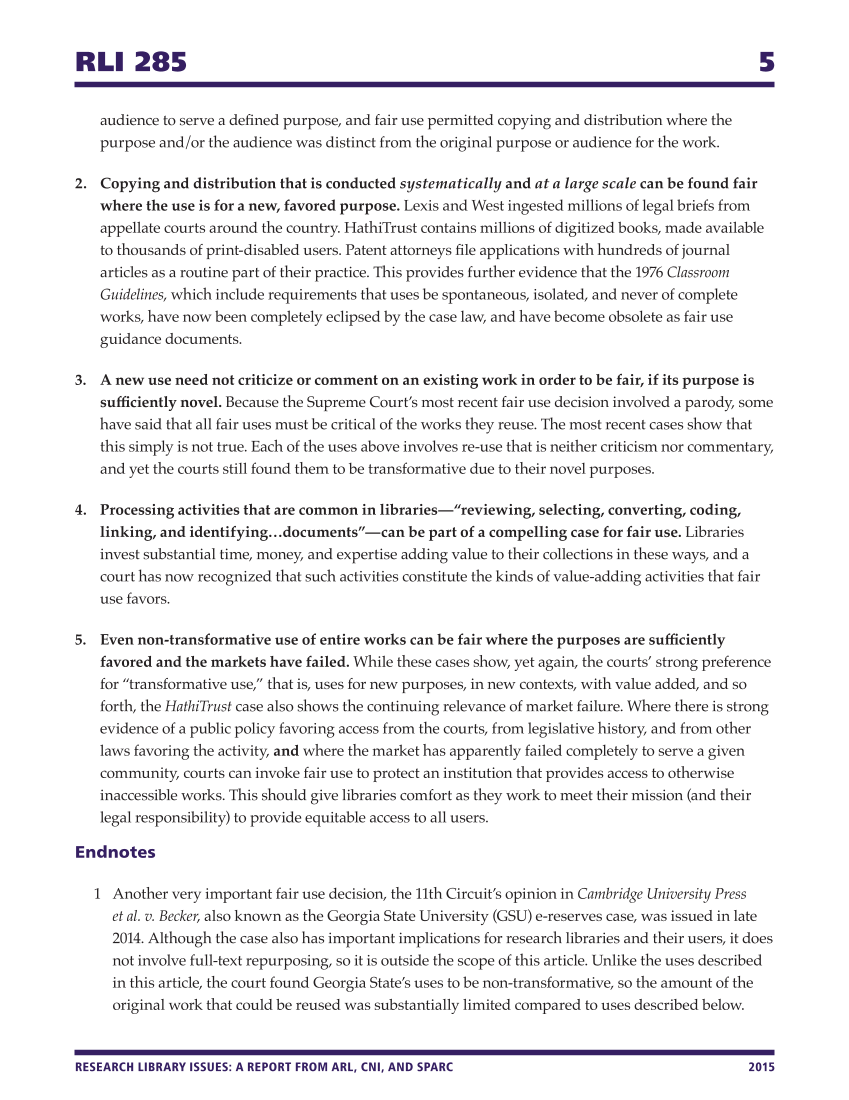RLI 285 5 RESEARCH LIBRARY ISSUES: A REPORT FROM ARL, CNI, AND SPARC 2015 audience to serve a defined purpose, and fair use permitted copying and distribution where the purpose and/or the audience was distinct from the original purpose or audience for the work. 2. Copying and distribution that is conducted systematically and at a large scale can be found fair where the use is for a new, favored purpose. Lexis and West ingested millions of legal briefs from appellate courts around the country. HathiTrust contains millions of digitized books, made available to thousands of print-disabled users. Patent attorneys file applications with hundreds of journal articles as a routine part of their practice. This provides further evidence that the 1976 Classroom Guidelines, which include requirements that uses be spontaneous, isolated, and never of complete works, have now been completely eclipsed by the case law, and have become obsolete as fair use guidance documents. 3. A new use need not criticize or comment on an existing work in order to be fair, if its purpose is sufficiently novel. Because the Supreme Court’s most recent fair use decision involved a parody, some have said that all fair uses must be critical of the works they reuse. The most recent cases show that this simply is not true. Each of the uses above involves re-use that is neither criticism nor commentary, and yet the courts still found them to be transformative due to their novel purposes. 4. Processing activities that are common in libraries—“reviewing, selecting, converting, coding, linking, and identifying…documents”—can be part of a compelling case for fair use. Libraries invest substantial time, money, and expertise adding value to their collections in these ways, and a court has now recognized that such activities constitute the kinds of value-adding activities that fair use favors. 5. Even non-transformative use of entire works can be fair where the purposes are sufficiently favored and the markets have failed. While these cases show, yet again, the courts’ strong preference for “transformative use,” that is, uses for new purposes, in new contexts, with value added, and so forth, the HathiTrust case also shows the continuing relevance of market failure. Where there is strong evidence of a public policy favoring access from the courts, from legislative history, and from other laws favoring the activity, and where the market has apparently failed completely to serve a given community, courts can invoke fair use to protect an institution that provides access to otherwise inaccessible works. This should give libraries comfort as they work to meet their mission (and their legal responsibility) to provide equitable access to all users. Endnotes 1 Another very important fair use decision, the 11th Circuit’s opinion in Cambridge University Press et al. v. Becker, also known as the Georgia State University (GSU) e-reserves case, was issued in late 2014. Although the case also has important implications for research libraries and their users, it does not involve full-text repurposing, so it is outside the scope of this article. Unlike the uses described in this article, the court found Georgia State’s uses to be non-transformative, so the amount of the original work that could be reused was substantially limited compared to uses described below.























